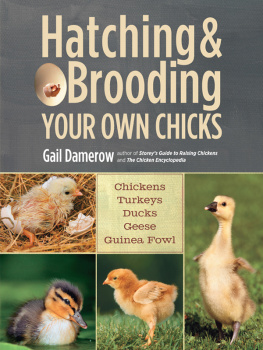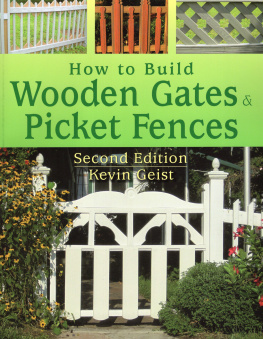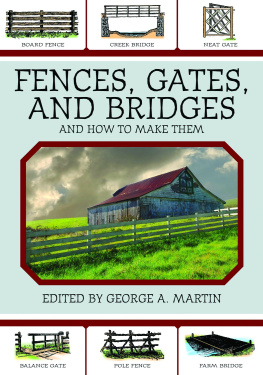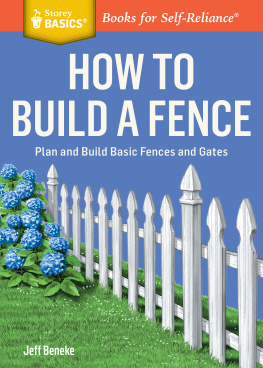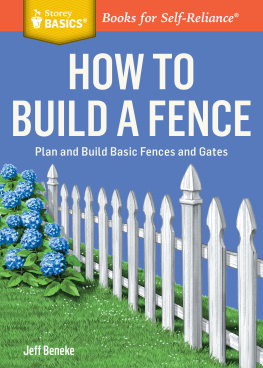Gail Damerow - Fences for Pasture & Garden
Here you can read online Gail Damerow - Fences for Pasture & Garden full text of the book (entire story) in english for free. Download pdf and epub, get meaning, cover and reviews about this ebook. year: 2011, publisher: Storey Publishing, genre: Home and family. Description of the work, (preface) as well as reviews are available. Best literature library LitArk.com created for fans of good reading and offers a wide selection of genres:
Romance novel
Science fiction
Adventure
Detective
Science
History
Home and family
Prose
Art
Politics
Computer
Non-fiction
Religion
Business
Children
Humor
Choose a favorite category and find really read worthwhile books. Enjoy immersion in the world of imagination, feel the emotions of the characters or learn something new for yourself, make an fascinating discovery.
- Book:Fences for Pasture & Garden
- Author:
- Publisher:Storey Publishing
- Genre:
- Year:2011
- Rating:3 / 5
- Favourites:Add to favourites
- Your mark:
- 60
- 1
- 2
- 3
- 4
- 5
Fences for Pasture & Garden: summary, description and annotation
We offer to read an annotation, description, summary or preface (depends on what the author of the book "Fences for Pasture & Garden" wrote himself). If you haven't found the necessary information about the book — write in the comments, we will try to find it.
Fences for Pasture & Garden — read online for free the complete book (whole text) full work
Below is the text of the book, divided by pages. System saving the place of the last page read, allows you to conveniently read the book "Fences for Pasture & Garden" online for free, without having to search again every time where you left off. Put a bookmark, and you can go to the page where you finished reading at any time.
Font size:
Interval:
Bookmark:
FENCES
for
Pasture & Garden
BY GAIL DAMEROW

The mission of Storey Publishing is to serve our customers
by publishing practical information that encourages personal independence
in harmony with the environment.
In memory of Carolyn, who started me thinking
seriously about fences because she wouldnt stay put.
Cover design by Carol Jessop.
Cover photographs by Craig Blouin (f/STOP PICTURES) upper leftx; Paul O. Boisvert upper right; David M. Stone.
(PHOTO/NATS) bottom
Text design and production by Carol Jessop.
Edited by Kimberley Foster.
Line drawings by Carl Kirkpatrick, except those by Allan Damerow on pages 6 and 18 (T-post clip)
Indexed by Gail Damerow.
Copyright 1992 by Gail Damerow.
All rights reserved. No part of this book may be reproduced without permission in writing from the publisher, except by a reviewer, who may quote brief passages or reproduce illustrations in a review with appropriate credits; nor may any part of this book be reproduced, stored in a retrieval system, or transmitted in any form or by any means electronic, photocopying, recording or other without permission in writing from the publisher.
The information in this book is true and complete to the best of our knowledge. All recommendations are made without guarantee on the part of the author or Storey Publishing. The author and publisher disclaim any liability in connection with the use of this information. For additional information please contact Storey Publishing, 210 MASS MoCA Way, North Adams, MA 01247.
Trademark names are used in this book. Neither the author nor Storey Publishing is supported by, affiliated with, or are owners of these trademarks nor do either endorse these trademark products over other similar products.
Storey books are available for special premium and promotional uses and for customized editions. For further information please call 1-800-793-9396.
Printed in the United States by Vicks Lithograph & Printing Corporation.
30 29 28 27 26 25 24 23 22 21 20 19
Library of Congress Cataloging-in-Publication Data
Damerow, Gail.
Fences for pasture and garden / by Gail Damerow.
p. cm.
Includes bibliographical references and index.
ISBN 0-88266-754-8 (hc) ISBN 0-88266-753-X (pb)
1. FencesDesign and construction. I. Title.
TH4965.D35 1992
631.27dc20
91-55486
CIP.
(Choosing the right fence and assembling supplies)
(Wood, steel, concrete, stone, fiberglass, and plastic)
(Installing anchor assemblies and line posts)
(Methods and tools for getting posts into the ground)
(Selecting materials and tools for a multi-strand fence)
(Constructing nonelectrified wire fences and trellises)
(Selecting a plug-in, solar, or battery controller)
(Connecting, grounding, and troubleshooting)
(Low- and high-tension smooth wire fences)
(Electroplastic net, reels, panels, and snow fence)
(Square, diamond, hexagonal, vinyl, and chain link mesh)
(Wood, vinyl, concrete, steel, fiberglass, and electric)
(Walk-through, drive-through, electric, and water gates)
No matter what project my husband and I decide to tackle, it always seems to come down to the same thing: fences. Fences to keep groundhogs and cottontails out of our garden. Fences to keep our dairy goats away from our fruit trees. Fences to keep our chickens in and the neighbors dogs out There was even a time when we had to fence in the house to keep our watch geese from taking over the basement.
As we quickly learned, installing a fence is a major investment in time and money. Buying materials and putting up a fence, though, is only half of whats involved the other half is making sure youre building the right fence for the job.
The more we researched the subject, the more discouraged we became about selecting the right fence for our purposes, our terrain, our climate, and our budget. Specific information is hard to come by. What little is available is confusing and fragmented. Even wordy mail-order catalogs, with their inadequate product descriptions and fantastic claims of superiority, make little sense.
One thing has become clear to us fence technology has changed enormously over the past two decades. However, the information has been slow to spread beyond the bounds of select experts, despite the highly touted information age into which weve supposedly entered.
As our research progressed and the full range of possibilities began to unfold, it occurred to me that the data we were amassing would be as valuable to others as it has been to us. So Ive put it all together in this book, including not only information on how to select the right fence for the job but also on how to install it properly so it does the job right.
Selecting the best fence isnt always easy, since each system has its own inherent strengths and weaknesses. Maybe youll find, as we did, that a combination works best for you. At our place, for example, we erected a post and plank fence at our driveway entry because its impressive and picturesque, especially with purple irises surrounding the posts and shocking-pink roses climbing the rails. We use electric fences along the property line as a sure but inexpensive way to keep our animals in and protect them from marauding dogs and coyotes. We use stock panels to control motivated livestock during breeding season, woven wire to confine our chickens, and portable electroplastic netting to pasture young animals in spring. Weve learned, you see, that there is no one right fence only the right fence for the job at hand.
One of our current jobs is trellising grape and berry vines. When we discovered high-tensile wire, we thought it would be perfect for solving our sagging trellis wire problem. It was. But we didnt really discover anything new; high-tensile wire has long been used for trellises in Australia and New Zealand, and was introduced to commercial vineyards here ten years before we discovered it.
This book, then, describes not only barriers that deter animals from getting in or getting out but also trellises that confine permanent plantings such as grapes, brambles, and espaliered fruit trees. It also covers fences designed to control blowing sand or snow. At the back of the book is a list of sources for fencing materials and a glossary explaining the specialized language used by contractors and suppliers.
I would like to thank my husband, Allan, for helping with the charts and illustrations and, throughout my research and writing, for seeing that I never ran out of my primary source of fuel, hot tea.
Also a great big thank you goes to Bill McCamman of New Zealand Fence Systems and John McCall of Lifetime Fence for reviewing the entire manuscript and keeping me on the straight and narrow;
to the snowman, Bob Jairell of The Rocky Mountain Forest and Range Experiment Station in Laramie, Wyoming, for bringing me up to date on snow fences;
to Bill Sites of the U.S. Forest Service in Asheville, North Carolina, for filling me in on the latest in wood and wood preservatives;
to Randy Hussung of Seymour Manufacturing for enlightening me on post hole diggers;
to George and Jennie Ivey, novice fence builders, for ferreting out potentially confusing passages so I could fix them;
and finally, to Stan Potratz of Premier Fence, for inspiring me to write this book in the first place.
Build all your fences horse high, pig tight, and bull strong, the old saying goes. But, with all the different options, how do you decide which kind of fence to build in the first place? The possibilities are nearly limitless, and no one elses fencing needs are exactly like yours.
Next pageFont size:
Interval:
Bookmark:
Similar books «Fences for Pasture & Garden»
Look at similar books to Fences for Pasture & Garden. We have selected literature similar in name and meaning in the hope of providing readers with more options to find new, interesting, not yet read works.
Discussion, reviews of the book Fences for Pasture & Garden and just readers' own opinions. Leave your comments, write what you think about the work, its meaning or the main characters. Specify what exactly you liked and what you didn't like, and why you think so.


